Mexican bread, particularly concha bread, is a beloved treat that holds a special place in the hearts of many. With its soft, pillowy texture and sweet, crunchy topping, concha bread has become a staple in bakeries across Mexico and beyond. Whether you’ve experienced the joy of biting into a fresh concha or are about to try making your own, this iconic bread is truly a delight. In this guide, we’ll walk you through everything you need to know about making Mexican concha bread from scratch, including the history, ingredients, and expert tips to get that perfect fluffy texture and irresistible topping. Ready to bake your own conchas? Keep reading for the ultimate recipe and step-by-step instructions!
Table of Contents
Why Concha Bread Should Be Your Next Baking Adventure
What is Concha Bread? A Closer Look at This Iconic Mexican Pastry
Mexican bread is a beloved category of baked goods, and concha bread stands as one of its most iconic varieties. This sweet, round pastry is renowned for its soft, airy interior and signature crunchy, sugar-coated topping that mimics the shape of a seashell—hence its name, “concha.” Often enjoyed with a hot beverage like coffee or hot chocolate, concha bread offers a perfect balance of subtle sweetness and rich texture. Traditionally baked in Mexican households and bakeries, it has become a symbol of Mexican cuisine, bringing together centuries of baking traditions with each warm, flavorful bite.
The History and Cultural Significance of Conchas
The history of Mexican bread is rich and deeply intertwined with the country’s cultural heritage, and concha bread holds a special place in this tradition. Originating during the colonial era, concha bread was influenced by European baking techniques, particularly French brioche, yet it was adapted with local ingredients and flavors. Over time, this sweet, soft bread became a beloved staple across Mexico, enjoyed at breakfast or during celebrations. Its unique, shell-like topping symbolizes the fusion of old-world craftsmanship and Mexican creativity. Concha bread represents more than just a treat—it’s a symbol of community, family, and the enduring flavors of Mexican cuisine.
Why Conchas Are So Special: The Perfect Blend of Texture and Flavor
Mexican bread is known for its rich, diverse flavors, and concha bread stands out as a true masterpiece. The allure of concha bread lies in its perfect balance of textures. The soft, fluffy interior contrasts beautifully with the slightly crunchy, sugar-coated topping. This blend creates an irresistible mouthfeel, while the subtle sweetness offers a comforting, yet complex flavor profile. The dough itself is light and airy, almost melt-in-your-mouth, while the topping—often flavored with vanilla, chocolate, or cinnamon—adds depth and richness. Whether enjoyed alone or with a warm drink, concha bread offers a truly satisfying sensory experience.
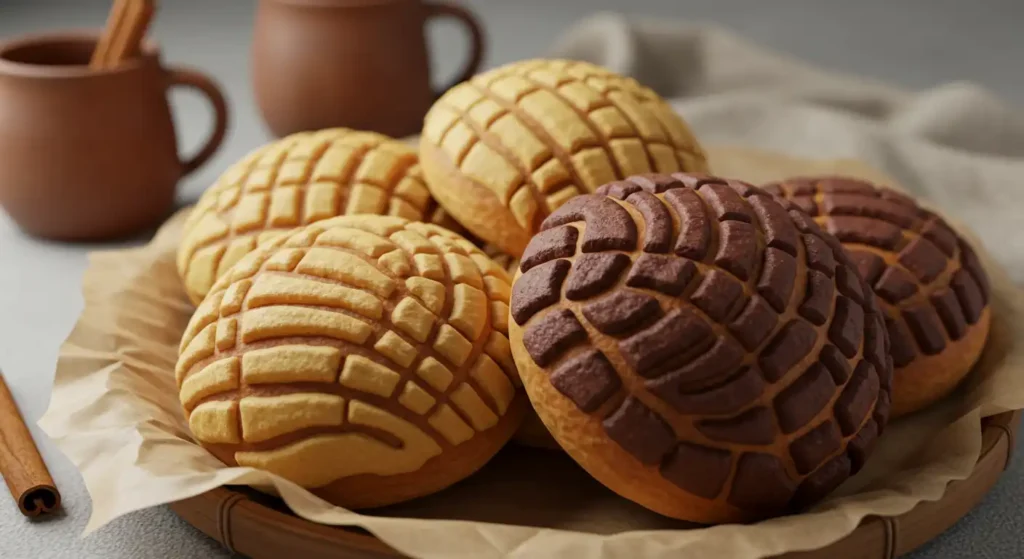
Essential Ingredients for Perfect Concha Bread
Key Ingredients: Flour, Sugar, Butter, and More
The foundation of any great Mexican bread, especially concha bread, lies in its key ingredients. High-quality flour is essential for creating that light, fluffy texture that defines concha bread. Sugar adds a gentle sweetness, perfectly balanced by the richness of butter, which imparts a tender crumb and buttery flavor. The inclusion of milk and eggs enhances both the texture and richness, while yeast works its magic to create the bread’s signature airy rise. These simple, yet essential ingredients combine to create a harmonious dough that, once baked, transforms into the soft, slightly sweet masterpiece known as concha bread.
The Role of Yeast in Achieving That Light and Fluffy Texture
The secret to achieving the signature light and fluffy texture of Mexican bread, particularly concha bread, lies in the use of yeast. Yeast is a microorganism that ferments the dough’s sugars, creating carbon dioxide gas as a byproduct. This gas gets trapped in the dough, causing it to rise and create that airy, soft structure that concha bread is known for. The yeast not only contributes to the texture but also adds a subtle depth of flavor, enhancing the overall experience. Without the proper yeast fermentation, concha bread would lack its characteristic fluffiness, making yeast a crucial ingredient in this beloved pastry.
How the Topping Comes Together: A Sweet, Crunchy Delight
The topping of Mexican bread, specifically concha bread, is what truly sets it apart. Made with a blend of butter, sugar, flour, and sometimes cocoa or cinnamon, it forms a crisp, sweet shell that contrasts beautifully with the soft, airy interior. The topping is carefully spread over the dough before baking, and as it cooks, it crisps up, creating a delightful crunch that’s both flavorful and visually appealing. This sugar coating not only enhances the sweetness of concha bread but also provides a textural contrast that makes each bite a delightful experience. The topping is what gives concha bread its signature look and irresistible taste.
Optional Add-ins for a Unique Twist on Tradition
While Mexican bread in its classic form is already a delight, there are plenty of ways to put a unique twist on concha bread. Adding cocoa powder to the dough creates a rich, chocolate-flavored base, while flavored extracts like vanilla or almond can infuse the bread with aromatic depth. For an even more indulgent treat, try mixing in chopped nuts, such as pecans or almonds, into the dough or topping. The crunchy sugar coating can be customized with food coloring or sprinkles, giving concha bread a vibrant, festive touch. These optional add-ins allow for endless creativity while keeping the essence of Mexican bread intact.
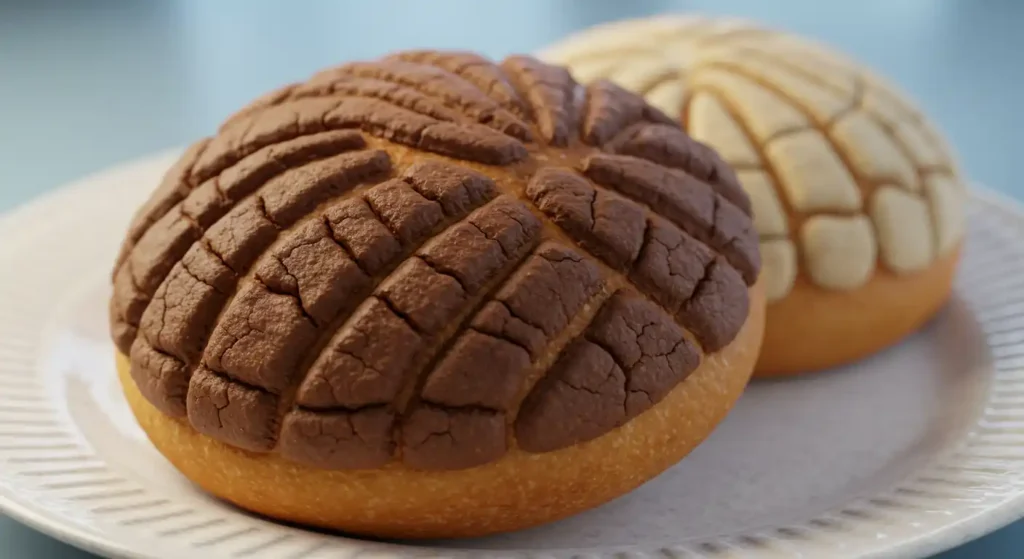
Step-by-Step Guide to Making Concha Bread
Preparing the Dough: Mixing, Kneading, and Rising
Preparing the dough for Mexican bread, specifically concha bread, is a crucial step in achieving that perfect texture. The process begins by mixing the ingredients—flour, sugar, yeast, and butter—until they form a smooth, cohesive dough. Kneading is essential to develop the gluten, which gives the bread its airy structure. This step should be done with care, allowing the dough to become elastic and soft. After kneading, the dough needs to rise, typically for an hour or until it has doubled in size. This fermentation process is what makes concha bread light and fluffy, creating the perfect base for its signature sweet topping.
How to Shape Your Conchas for the Perfect Round Form
Shaping Mexican bread, particularly concha bread, requires a delicate touch to achieve the perfect round form. After the dough has risen, divide it into evenly sized-portions. Gently roll each portion into a smooth ball, making sure not to deflate the dough too much, as this can impact the bread’s light, airy texture. When shaping concha bread, it’s essential to handle the dough with care, maintaining its integrity. Once shaped, the dough should rest for a short time before being topped with the signature sugar coating. This careful shaping process ensures the concha bread will bake into a beautifully round, fluffy pastry with a crisp topping.
Creating the Signature Topping: Tips for That Beautiful Sugar Design
Creating the signature topping for Mexican bread, specifically concha bread, is an art form that adds both visual appeal and texture. The topping is typically made with a combination of sugar, butter, flour, and a dash of vanilla or cocoa for flavor. To achieve that classic shell-like design, the sugar mixture is spread evenly over the dough and scored into patterns, often resembling a shell’s ridges. The key is to work quickly, as the butter-based topping can soften. For a perfect finish, the sugar topping should be slightly cracked and golden after baking, offering a delightful crunch that contrasts beautifully with the soft, airy interior of concha bread.
Baking the Conchas: Ideal Temperature and Timing for Golden Brown Results
Baking Mexican bread, especially concha bread, requires precise timing and temperature for the perfect golden-brown finish. Preheat the oven to 350°F (175°C) to ensure even heat distribution. Once the dough has been shaped and topped, place the conchas on a lined baking sheet, leaving space between each piece for expansion. Bake for about 18 to 20 minutes, or until the sugar topping is lightly cracked and the bread is golden on the edges. The key to achieving that iconic crispy topping and soft interior is to monitor closely towards the end of baking. The result should be a delightful contrast of textures in every bite of concha bread.
Mastering the Techniques for Soft, Fluffy Conchas
The Science Behind Proper Kneading and Resting Time
The science behind proper kneading and resting time is crucial for achieving the perfect texture in Mexican bread, particularly concha bread. Kneading helps develop gluten, the protein that provides structure and elasticity to the dough. As the dough is worked, gluten strands form, allowing the dough to rise and hold air bubbles, creating a light and airy texture. Resting time allows the yeast to ferment, producing carbon dioxide, which causes the dough to expand. This process gives concha bread its soft, fluffy interior. Skipping either kneading or resting can result in dense, unappealing bread, making these steps essential for perfect results.
Temperature Control: Creating the Best Environment for Rising Dough
Temperature control plays a vital role in the rise of dough when making Mexican bread, particularly concha bread. Yeast thrives in warm environments, so it’s essential to find the right temperature for the dough to ferment. Ideally, the dough should rise in a room around 75°F to 80°F (24°C to 27°C). Too cold, and the yeast activity slows down, leading to a dense texture; too hot, and the yeast can be killed, preventing proper rise. Creating a warm, draft-free area, such as an oven with the light on or a warm kitchen, ensures that concha bread dough rises evenly and achieves the perfect airy, fluffy texture.
How to Keep Your Conchas Soft and Moist, Not Dry
To keep Mexican bread, especially concha bread, soft and moist, several key factors must be considered. First, ensure that the dough is properly hydrated by using enough milk or water to achieve a slightly sticky texture. Avoid overbaking, as this can lead to dryness; concha bread should be golden on the outside, but still tender inside. Additionally, after baking, store the conchas in an airtight container or wrap them in a clean kitchen towel while they cool to retain moisture. A small slice of apple or a damp paper towel in the container can also help maintain softness, keeping the concha bread fresh longer.
Troubleshooting Common Issues: What to Do if Your Dough Isn’t Rising
If your Mexican bread, particularly concha bread, isn’t rising as expected, there are a few potential culprits. First, check the freshness of your yeast. Expired yeast can lead to sluggish or no rise. If the dough feels too dense, ensure that you’re using the correct flour and hydrating it sufficiently. Temperature plays a big role too—ensure the dough is in a warm, draft-free spot for fermentation. If it’s too cold, try placing it near a warm oven or using a proofing box. Lastly, avoid overworking the dough, as this can cause the yeast to lose its effectiveness, preventing the proper rise of concha bread.
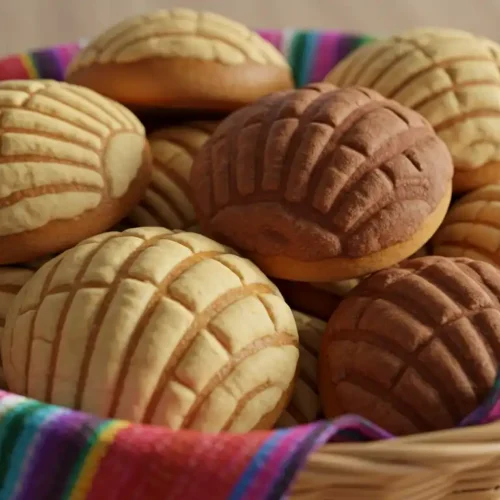
Explore Mexican Bread Varieties.
Equipment
- Mixing bowls
- Rolling pins
- Baking sheets
- Oven
Ingredients
For Bolillos:
- Flour
- Water
- Yeast
- Salt
For Conchas:
- Flour
- Sugar
- Eggs
- Butter
- Sweet topping mixture
Instructions
Bolillos:
- Mix flour, water, yeast, and salt to form a dough.
- Knead until smooth and elastic, then allow it to rise.
- Shape into rolls, maintaining their classic elongated form.
- Bake in a hot oven until golden brown and fluffy inside.
Conchas:
- Prepare a soft dough using flour, sugar, eggs, and butter.
- Form dough balls and top with sweet, crunchy “shell” topping.
- Bake until the topping sets and the pastry becomes soft and golden.
Notes
- Bolillos and conchas reflect Mexico’s culinary heritage.
- Each region and family has unique methods and recipes.
Creative Variations of Concha Bread
Flavorful Additions: Chocolate, Vanilla, and Cinnamon Conchas
Flavorful additions like chocolate, vanilla, and cinnamon can elevate Mexican bread, particularly concha bread, creating a delightful variation. For chocolate conchas, simply incorporate cocoa powder into the dough or topping, infusing it with a rich, deep flavor. Vanilla can be added to both the dough and topping, providing a sweet, aromatic undertone. Cinnamon, either mixed into the dough or sprinkled on top, adds a warm, spicy touch that complements the soft, airy texture of concha bread. These additions not only enhance the taste but also create visually striking conchas, making each bite a unique experience.
Vegan and Gluten-Free Options for Concha Lovers
For those seeking vegan or gluten-free alternatives, Mexican bread, specifically concha bread, can still be enjoyed with a few adjustments. Vegan versions replace dairy and eggs with plant-based options like almond milk, coconut oil, and egg substitutes such as flaxseed or chia. Gluten-free concha bread can be made using a blend of gluten-free flour, like rice flour or almond flour, ensuring a soft, yet firm texture. Both adaptations may require experimenting with different flour combinations or rising techniques, but with the right adjustments, these modified concha bread recipes offer the same irresistible taste and texture while catering to dietary preferences.
Decorating Beyond the Traditional: Colorful Toppings and Fun Designs
Decorating Mexican bread, especially concha bread, offers endless opportunities for creativity. While the traditional sugar topping is delicious, experimenting with vibrant colors and unique designs can take these pastries to the next level. Use food coloring to create eye-catching patterns like stripes or polka dots, adding a fun, festive flair. Alternatively, flavored sugars such as matcha or hibiscus can offer a twist on the classic flavor profile. These colorful toppings not only enhance the visual appeal of concha bread but also provide exciting flavor variations, making each concha a delightful work of art.
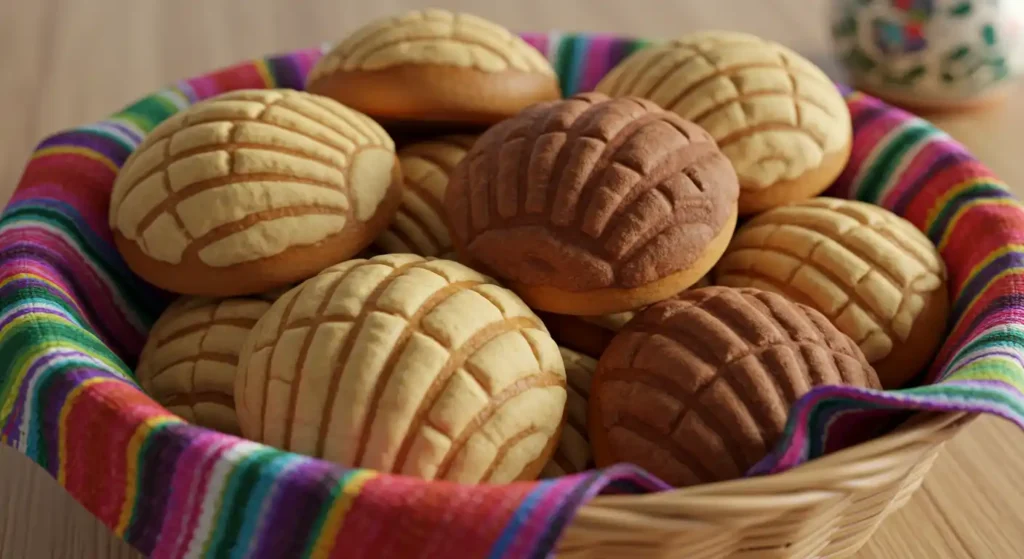
How to Serve and Store Concha Bread for Maximum Freshness
Best Ways to Serve Conchas: Pairing with Coffee, Hot Chocolate, or Tea
The best way to enjoy Mexican bread, specifically concha bread, is by pairing it with a warm beverage. The rich, soft texture of concha bread complements the boldness of freshly brewed coffee, offering a delightful contrast in flavors. For a more indulgent treat, pair it with a mug of hot chocolate, where the sweetness of the bread balances perfectly with the creamy cocoa. Tea lovers can enjoy concha bread with a mild herbal or chai tea, where the spices in the tea enhance the delicate sweetness of the bread. Each pairing elevates the flavors, creating a cozy, satisfying experience.
Storage Tips for Keeping Your Conchas Fresh for Longer
To keep Mexican bread, especially concha bread, fresh for longer, proper storage is essential. After baking, allow the conchas to cool completely before storing. Place them in an airtight container to maintain moisture and softness. For added longevity, you can individually wrap them in plastic wrap and then store them in a resealable bag. If you need to keep them for more than a few days, freezing is an excellent option. Simply wrap the concha bread in plastic and foil, and store it in the freezer. When ready to enjoy, just reheat in the oven for a few minutes to restore their fresh-baked texture.
Reheating Conchas: How to Bring Back the Softness and Freshness
Reheating Mexican bread, such as concha bread, requires a careful touch to restore its softness and freshness. For best results, wrap the conchas in a damp paper towel and heat them in the microwave for 15–20 seconds. This method helps retain moisture and softens the bread. Alternatively, if you prefer a slightly crispy exterior, place them in a preheated oven at 350°F (175°C) for about 5 minutes. The warmth will revive the fluffy texture of the concha bread while keeping the sugar topping intact. Whichever method you choose, conchas will taste almost as fresh as when they were first baked.
Frequently Asked Questions
What flavor profile does concha bread have?
Concha bread has a subtly sweet flavor with a hint of vanilla and butter. The topping adds a light crunch with a sugary sweetness, complementing the soft, pillowy interior. The overall flavor is rich but not overpowering, making it a perfect treat for any time of day.
What are the best pairings for concha bread?
Concha bread pairs wonderfully with warm beverages like coffee, hot chocolate, or fragrant herbal tea. The softness and sweetness of the bread contrast beautifully with the bitterness of coffee or the creamy richness of hot chocolate. It can also be enjoyed with fruit preserves or a light spread for an added layer of flavor.
How does concha differ from pan dulce?
While both are types of Mexican bread, concha bread is distinct due to its signature shell-like topping. Pan dulce is a broader term encompassing various sweet bread types, such as marranitos or carnitas, whereas concha bread specifically refers to round, sweet bread with a crunchy topping. The topping on conchas also gives them a unique texture and appearance.
What is the English translation of concha bread?
In English, concha bread is often referred to as “shell bread” due to its resemblance to a sea shell. The word “concha” translates to “shell” in Spanish, reflecting the iconic design of the bread’s sweet, crunchy topping. This name has become widely recognized in English-speaking regions.
What is the proper way to enjoy conchas?
Conchas are best enjoyed fresh, either at room temperature or slightly warmed. Some prefer breaking them apart with their hands to savor the soft, fluffy interior, while others may enjoy them with a hot beverage or as part of breakfast. There’s no right or wrong way, just a personal preference for how the bread enhances the experience.
Is it recommended to reheat a concha before eating?
Reheating concha bread can help restore its softness and bring back its fresh-baked aroma. A quick 10-15 seconds in the microwave or a few minutes in the oven can revive the bread’s texture without drying it out. Reheating can also enhance the flavor, especially when paired with a warm beverage.
What are the various concha bread flavors available?
In addition to the traditional vanilla flavor, concha bread comes in a variety of other delicious flavors, such as chocolate, strawberry, and cinnamon. Some variations may feature colorful toppings or fillings, while others stick to the classic designs. These flavor options offer something for everyone, from the simplest to the most adventurous tastes.
Why does the topping on my concha turn out sticky?
If the topping on your concha bread turns out sticky, it may be due to excess moisture or an imbalance in the sugar-to-flour ratio. The topping can also become sticky if the dough hasn’t fully cooled before being baked or if humidity levels are high. Ensuring the correct consistency of the topping mixture and allowing the dough to cool properly can help avoid this issue.
Enjoying Your Homemade Concha Bread
Why Making Concha Bread Is a Fun and Rewarding Experience
Making Mexican bread, especially concha bread, is an incredibly rewarding experience. The process allows you to craft a delightful treat from scratch, beginning with the soft dough and ending with the sweet, crunchy topping. As you shape the dough and design the iconic sugar patterns, it’s a fun and creative process. Watching the conchas rise and transform in the oven brings immense satisfaction. The fragrant aroma fills your kitchen, signaling that you’ve created something truly special. The joy continues as you indulge in the first bite, savoring the fluffy texture and sweet flavors of your homemade concha bread.
Sharing the Joy: Conchas as a Gift or for Special Occasions
Concha bread is not just a delicious treat; it’s a symbol of celebration and community. Offering Mexican bread as a gift is a heartfelt gesture that brings people together. Whether shared at a family gathering, a special occasion, or as a thoughtful present, conchas add warmth and joy to any moment. Their colorful sugar topping and soft, fluffy texture make them an irresistible delight. Sharing these freshly baked treasures creates lasting memories, making them the perfect way to mark celebrations, and holidays, or simply brighten someone’s day with the sweet charm of concha bread.
Final Thoughts: Your Ultimate Concha Bread Recipe Journey
Your journey to perfecting concha bread is a rewarding one. With each step, from kneading the dough to creating the signature sugar topping, you’re not just baking Mexican bread; you’re crafting a piece of tradition. The process, though intricate, offers a rich reward: soft, fluffy bread with a delightful, sweet crunch. As you hone your skills, experiment with flavors and toppings, and share your creations, you’ll discover the true joy of baking concha bread. This recipe will undoubtedly become a cherished part of your culinary repertoire, blending history, flavor, and creativity in every bite.

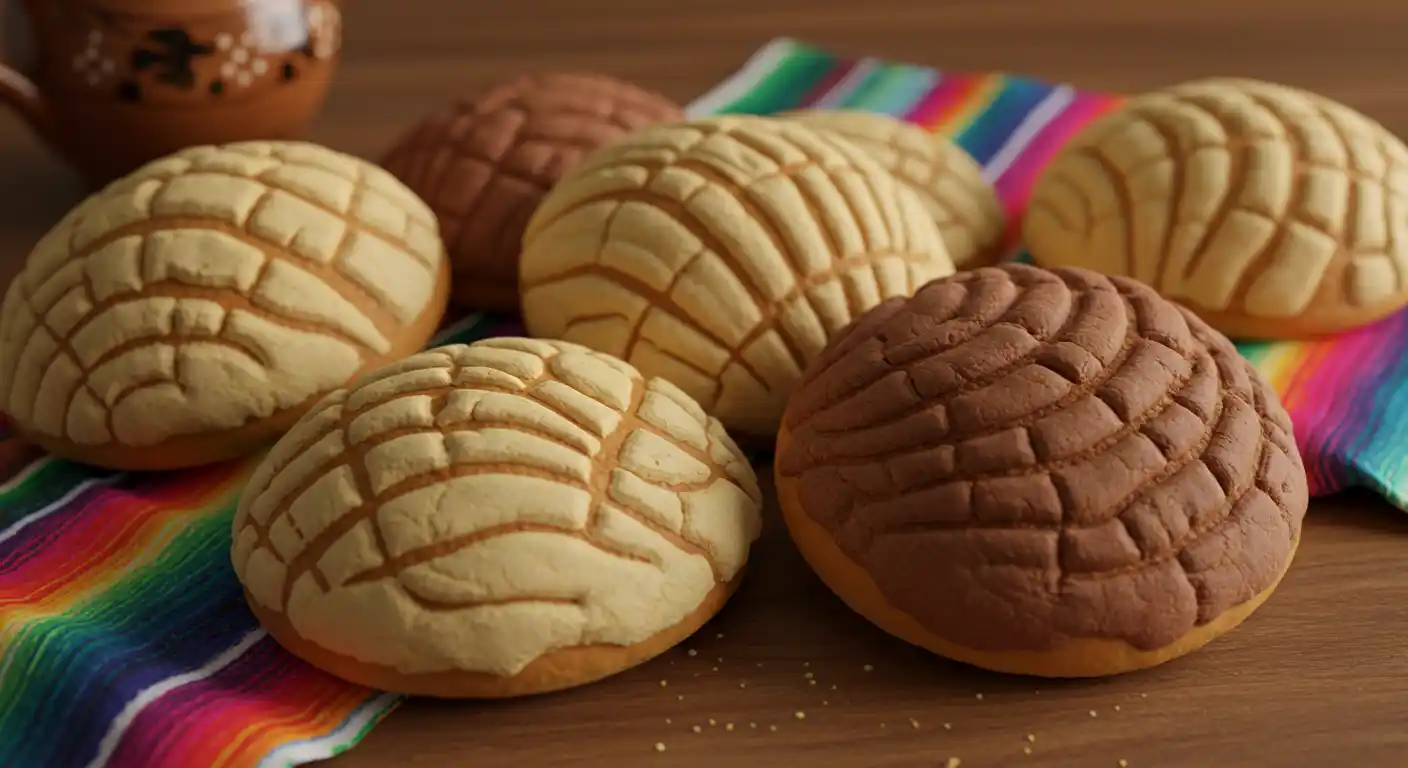
2 thoughts on “Mexican Bread: The Ultimate Concha Bread Recipe”